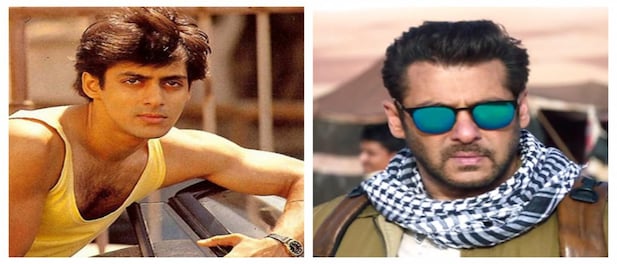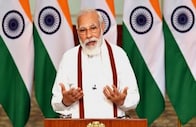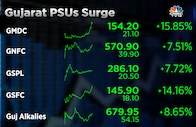Ahead of the big Eid 2023 release, a good look at the evolution of Salman Khan’s superstardom over the years.
With every new Salman Khan film, I’m getting more and more convinced that the gravity-and-logic-defying superstar of today has little to do with the charming, youthful heartthrob of the Nineties.
It’s almost as if devastated by the spate of flops and personal mishaps at the turn of the century, Khan burned down his on-screen persona and reconstructed himself anew, discarding the sweet, earnest lover-boy for the larger-than-life messiah of the masses. Today, he wears his ultimate saviour image as a shield, wields it as a weapon. It protects him from it all—ridiculous, robotic performances, box-office failures, legal battles, his brazen, devil-may-care attitude.
Let me better illustrate the absolute degeneration of Khan’s artistry over the years through two of his songs. Watch Dholi Taaro Dhol Baaje from Sanjay Leela Bhansali’s 1999 blockbuster Hum Dil De Chuke Sanam. In a wonderfully choreographed performance by Vaibhavi Merchant (for which she won a national award), he matches co-star Aishwarya Rai Bachchan—a trained classical dancer—step for step, beat for beat. Together, they illuminate the screen, all lithe, gorgeous, graceful, flowing in love; it’s a visual feast. Now, see him dance to Billi Billi, one of the tracks from his big Eid release, Kisi Ka Bhai Kisi Ka Jaan. Put together by Jaani Master, it’s a painful watch. Khan can barely move and whenever he does, it hurts. It’s not just me, show it to any cinephile (except the fans of the Bhaijaan brand of cinema obviously) and they’d weep tears of agony at how this performer has devolved and how little he cares anymore.
As weary as I have been of his movies for the last two decades, this wasn’t always the case. I loved Salman Khan before he became Bhai. I may have consciously not watched any of his films since Dabangg (2010) but I still fondly revisit his early work. Our world and how we make and consume cinema have changed drastically since Sooraj Barjatya’s directorial debut Maine Pyar Kiya came out in 1989. But there is an inherent innocence, sweetness, and simplicity in that film, in Prem and Suman’s love story that is still immensely watchable.
Though they are more gaudy, dramatic, and long-drawn, Khan’s Prem in Barjatya’s subsequent superhits Hum Aapke Hain Koun (1994) and Hum Saath Saath Hain (1999) was the counterfoil of everything he stands for and propagates today in his films. Both the characters were sensitive, rooted, earnest, subtle, restrained, everything that our Bhai of today is proudly not.
Not just his on-screen characters, but even the subtext of these films spoke a lot about Khan’s security as an actor, and his eagerness to prove himself and cement his position. Several leading men of the time famously refused to work in Hum Aapke Hain Koun because it was essentially a Madhuri Dixit film. Prem was second to Nisha, who was the film’s actual hero. But Khan, then not as big a star as Dixit, took on the role and made it his own. The rest, as they say, is history.
The case of Hum Saath Saath Hain wasn’t too different either. Though Khan was its biggest draw, he wasn’t the only lead. The film had an illustrious ensemble, featuring three parallel love stories all rooted within the same family and starring some of the top guns of the time, including Tabu, Saif Ali Khan, Karisma Kapoor, and Sonali Bendre. Barajtya pulled off a casting coup that no director can dare imagine today. Karan Johar did before the pandemic. The result? As of now, Takht has been stalled indefinitely.
Khan was always infamous for his bratty, brash behavior, but in his younger days, when he wasn’t so stupefied by his own superstardom, he had the willingness to perform and experiment; he didn’t mind not being the lead or not always getting the girl. Remember his Akash Varma from Saajan (1991) or Aman Mehra from Kuch Kuch Hota Hai (1998) and the grace and equanimity with which they let go? Absolutely heartbreaking. Or take Andaz Apna Apna (1994), Judwaa (1997), and Biwi No. 1 (1999). All of them are comedies and yet so refreshingly different from each other. Whatever happened to that?
His contemporaries, the other two Khans, are each going through a renaissance of sorts, fielding third innings. Both Shah Rukh and Aamir have seen massive highs and debilitating lows in their prolific careers, but they never stopped experimenting. Now nearing 60, they are still as eager to introspect, reinvent, and work hard as they were when they started out about 35 years ago. Salman Khan then stands as a rare anomaly whose success isn’t dependent on merit or malleability. Ever since Wanted (2009), the name of his characters and films keep changing, but he continues to be Salman Khan in each of them—steadfast and unfazed.
During one of his appearances on Koffee with Karan, Aamir once said that Salman Khan is Hindi cinema’s only true-blue superstar for he doesn’t need a script, a story, or a solid team of technicians. He doesn’t have the pressure to make a good film. All he needs to do is move his waist belt as a hook step, put a pair of Ray-Ban sunglasses at the nape of his collar and the audience goes wild. Depending on which side of the fence you stand, you can construe this as a scathing comment or a generous compliment. That is the real power of Salman Khan.
Check out our in-depth Market Coverage, Business News & get real-time Stock Market Updates on CNBC-TV18. Also, Watch our channels CNBC-TV18, CNBC Awaaz and CNBC Bajar Live on-the-go!







